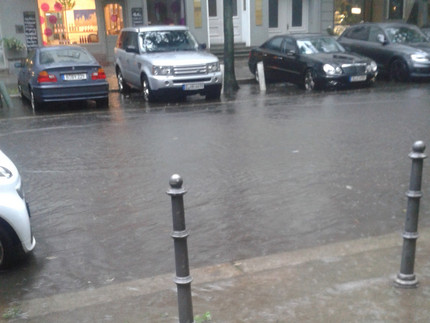Task Force Pluvial Flooding in Berlin (Germany)
In the summers of 2017 and 2019, the city of Berlin was hit by heavy rainfall leading to urban flooding in several locations due to limited capacities of the sewer systems. In both years, this led to considerable disruptions of the daily life and high property damage. With focus on two particularly impressive events in 2017 and 2019 a taskforce, consisting of two subgroups, investigated (1) the meteorological characteristics of both events as well as (2) the hazard and vulnerability of the Berlin population to heavy rainfall.
A comparative meteorological reconstruction of the 2017 and 2019 heavy rainfall events revealed fundamental differences between the two storms. For example, the 2017 event was not a typical heavy rain event, as it was characterised by a relatively large spatial extent and long duration of rain, whereas the 2019 storm was a typical short duration heavy rain event with a distinct spatial heterogeneity. Subsequent statistical analysis indicated that the 2017 event should be classified as a large-scale extreme event with exceedance probabilities below 1 % for longer precipitation durations (i.e., return periods of over 100 years). In contrast, in 2019 similar exceedance probabilities were observed only locally and for shorter durations (1-2 h).
The vulnerability analysis was based on an online survey that the taskforce conducted in Berlin in April - June 2020. The survey addressed Berlin residents that had experienced past heavy rainfall events, and yielded to answer questions related to impairments and damages, risk perception, and emergency and preparedness measures. The survey data (n=102) primarily referred to the events of 2017 and 2019 and showed that the respondents were affected by the storms both in their daily lives (e.g., when purchasing food) and in their own households (e.g., due to flood damage). In addition, the analysis of the responses pointed to ways to further reduce society's vulnerability to heavy rain. That was, for example, by providing support to particularly affected groups (e.g., caregivers), through targeted information campaigns to protect against heavy rainfall or by improving the range of early warning systems. A statistical analysis of the effectiveness of private emergency and preparedness measures based on the survey data confirmed previous study findings and provided evidence of reducing heavy rain damage through preparedness.
The findings of the taskforce highlight the need for integrated heavy rainfall risk management that considers the risk components of hazard, vulnerability, and exposure holistically and at multiple levels (e.g., state, local and private households).
The report was published by University Press of University of Potsdam . It is written in German and can be accessed via this link: https://doi.org/10.25932/publishup-50056

